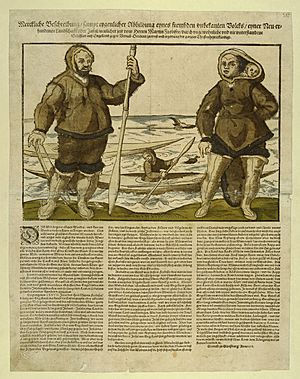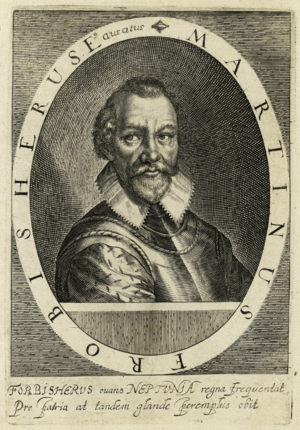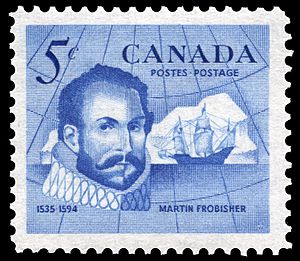Martin Frobisher facts for kids
Quick facts for kids
Sir Martin Frobisher
|
|
|---|---|
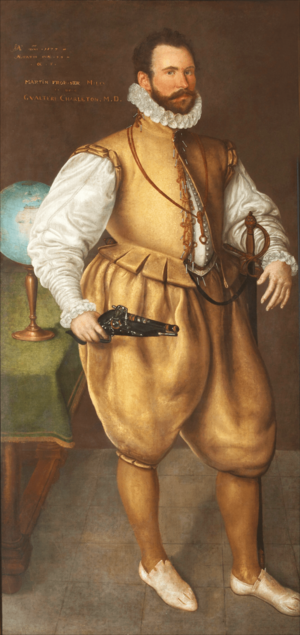
Sir Martin Frobisher by Cornelis Ketel, 1577
|
|
| Born | c. 1535 or 1539 Altofts, Yorkshire, England
|
| Died | 22 November 1594 (aged 55–59) Plymouth, England
|
| Nationality | English |
| Occupation | Seaman |
| Spouse(s) | Dorothy Wentworth |
| Parent(s) | Bernard Frobisher and Margaret York |
| Signature | |
Sir Martin Frobisher (c. 1535 – 22 November 1594) was an English sailor and privateer. A privateer was like a pirate, but they had permission from their government to attack enemy ships. Frobisher made three trips to the New World (North America). He was looking for a sea route called the Northwest Passage. This passage was believed to connect the Atlantic and Pacific oceans.
He likely saw Resolution Island near Labrador in Canada. Then he sailed into Frobisher Bay and landed on Baffin Island. On his second trip, Frobisher found what he thought was gold. He brought 200 tons of it back to England. People were excited, so he returned to Canada with more ships. He dug for more "gold" around Frobisher Bay. He brought 1,350 tons of this rock back to England. But after years of testing, it turned out to be worthless rock. It contained a mineral called hornblende. Frobisher was later made a knight for his bravery. This was for helping to defeat the Spanish Armada in 1588.
Contents
Early Life and First Voyages
Martin Frobisher was probably born around 1535 or 1536. His father was Bernard Frobisher, a merchant from Altofts, Yorkshire. His mother was Margaret York. Martin was the third of five children. His father died in 1542, and his uncle, Francis Frobisher, took care of the family. Martin didn't get much formal schooling. In 1549, he moved to London to live with his relative, Sir John York. Sir John was a rich and powerful merchant.
In 1553, Frobisher joined an English trip to West Africa. He was part of the crew on one of three ships. They traded English cloth for gold on the Gold Coast. They also traded for pepper in Benin. Many sailors got sick and died on this trip. The leader, Thomas Wyndham, also died. Frobisher was one of only 40 survivors out of 140 men.
In 1554, Frobisher went on another trading trip to West Africa. He worked for Sir John York's trading partner. During this trip, Frobisher volunteered to be a hostage. This was to help with trade talks with local people. But a Portuguese ship attacked the English fleet. The English ships left Frobisher behind. His African captors then gave him to the Portuguese. He was held prisoner in a castle for about nine months. He finally returned to England around 1558.
Working as a Privateer
After his release, Frobisher quickly went back to sea. By 1559, he might have led a trip to rescue an English hostage. He was also accused of planning to attack the Portuguese fort where he had been held.
In 1563, Frobisher became involved in privateering. He worked with his brother and another man. They had permission to capture French Catholic ships. Frobisher commanded one of the ships. They seized five French ships. But Frobisher was arrested because his ship also attacked a Spanish ship. He was put in prison.
Frobisher was released in 1564. He bought two ships, planning to trade in Guinea. But officials were suspicious of his plans. He was arrested again briefly in 1565. In 1566, he was freed but told not to sail without a license. In 1568, he commanded a ship that attacked French shipping. He was arrested again in 1569. He stayed in prison until 1570, when important government officials helped him.
After his release, Frobisher worked for the government. In 1571, he was asked to find pirates along the English coast. In 1572, he helped the English army in Ireland.
Searching for the North-west Passage
For many years, England wanted to find a northern sea route to Asia. This route was called the North-west Passage. It would allow ships to sail to China and the East Indies. Many explorers tried to find it.
Frobisher became very interested in finding this passage. In 1574, he asked the Queen's advisors for support. They liked his idea but sent him to the Muscovy Company. This company had special rights to northern sea routes.
First Voyage to the Arctic
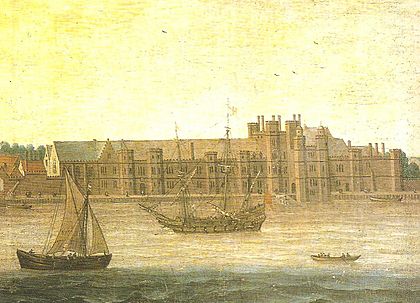
In 1576, Frobisher convinced the Muscovy Company to support his trip. With help from Michael Lok, he raised enough money. He had three small ships: Gabriel, Michael, and a smaller pinnace. There were 35 crew members in total. Queen Elizabeth liked their plans. The ships left London on June 7, 1576. As they sailed down the Thames River, Queen Elizabeth waved from Greenwich Palace. Cannons fired, and people cheered.
On June 26, the ships reached the Shetland Islands. They stopped to fix a leak and water barrels. They sailed west, but a big storm hit them. The small pinnace sank, and Michael turned back to England. But Gabriel kept going. On July 11, they saw Greenland, but thought it was an island called 'Friesland'.
They crossed the Davis Strait and faced another storm. Gabriel sailed on for four days. Then the crew saw land they thought was Labrador. It was actually the southern tip of Baffin Island. Frobisher named it "Queen Elizabeth's Foreland".
A few days later, the ship reached Frobisher Bay. Ice and wind stopped them from going north. Frobisher decided to sail west into the bay. He thought it was the entrance to the North-west Passage. He called it Frobisher's Strait. On August 18, they saw Burch's Island. There, they met some local Inuit people. Frobisher sent five men in a boat to shore with an Inuit guide. But his men got too close to other Inuit. The five English sailors were captured.
Frobisher searched for his men but couldn't find them. He took an Inuit man hostage, hoping to trade him for his sailors. But it didn't work. The English sailors were never seen again by their crew. However, Inuit stories say the men lived among them for a few years. They died trying to leave Baffin Island in their own boat.
Frobisher sailed home and was welcomed by the Queen. The crew brought back a black stone. It was found on Christopher Hall Island. The shipmaster thought it was sea-coal. Frobisher didn't think much of it. But Michael Lok, an investor, took samples to experts. They said it was worthless rock. Then Lok took it to an Italian alchemist, who claimed it had gold. This made people excited about finding gold in the new lands.
Second Voyage for "Gold"
In 1577, a much larger trip was planned. The Queen lent a 200-ton ship called Ayde. She also invested £1000. Frobisher asked to be made High Admiral of the northern seas. He also wanted a share of any profits.
The expedition included Ayde, Gabriel, and Michael. George Best, who wrote about the voyages, was second-in-command. The famous scholar John Dee taught Frobisher about navigation. The fleet left London on May 27. They had about 120 men, including sailors, gunners, and miners. Frobisher had too many men, so he had to send some ashore.
They sailed across the Atlantic. On July 4, they saw Greenland again. On July 8, Frobisher sailed west. The ships were caught in bad storms and separated. But they regrouped on July 17. A sailor saw Christopher Hall Island at the mouth of Frobisher Bay. Frobisher landed there to look for more black rock. On July 19, Frobisher and 40 men landed on Hall's Island. They climbed to the highest point, which he named Mount Warwick. They built a pile of stones to claim the land.
They spent weeks collecting the "ore." They didn't explore much, as their main goal was to get the rock. There were some talks and fights with the Inuit. They tried to get back the five men captured last year, but failed. The ships started their return to England on August 23, 1577.
Frobisher brought three Inuit people from Baffin Island to England. Their names were Kalicho, Arnaq, and Nuttaaq. All three died soon after arriving in England.
The Queen welcomed Frobisher at Windsor Castle. A lot of money was spent to test the 200 tons of "ore." It took a long time, and there were arguments among the investors.
Third Voyage and Disappointment
The Queen and others still believed in the new land's potential. She named it Meta Incognita (Unknown Shore). They decided to send an even bigger trip. The goal was to start a colony of 100 men. Frobisher was honored by the Queen. She gave him a gold chain.
The expedition had fifteen ships. There were over 400 men, including 147 miners. On June 3, 1578, they left Plymouth. On June 20, they reached southern Greenland. On July 2, they saw Frobisher Bay. Storms and ice caused problems. One ship, the Dennis, was wrecked on an iceberg. The fleet was accidentally driven into a new waterway. Frobisher called it 'Mistaken Strait'. This is now known as Hudson Strait. He thought it was less likely to be the North-west Passage. After sailing about sixty miles, he turned back. The fleet finally reached Frobisher Bay.
They tried to start a settlement. They loaded a large amount of "ore" onto the ships. But arguments and unhappiness stopped them from building a successful colony. On the last day of August, the fleet sailed back to England. They arrived in early October. One ship, the Emanuel, was wrecked off the coast of Ireland.
The "ore" was taken to a special plant in Dartford. For five years, they tried to get gold from it. But the rock was worthless. It contained hornblende. It was eventually used to build roads and walls. The company that funded the trips went bankrupt. Michael Lok, the investor, lost everything.
Fighting the Spanish Armada
After the "gold" turned out to be worthless, Frobisher's reputation as an explorer was hurt. He looked for other work. He joined Sir William Wynter, a trusted naval commander. Wynter was leading ships to Ireland to stop a rebellion. Frobisher became captain of the ship Foresight. In November 1580, he helped in the Siege of Smerwick.
Frobisher joined Francis Drake in 1585. They raided Spanish ports and ships in the West Indies. Frobisher was vice-admiral of Drake's fleet. His ship was the Primrose.
In 1588, the Spanish Armada sailed from Spain to invade England. Frobisher was in command of the Triumph. This was the Royal Navy's largest ship. He led a group of other ships.
Battle with the Spanish Armada

The English fleet was reorganized into four groups. Frobisher was made commander of one group. He was given Triumph and other powerful ships. On July 21, 1588, Frobisher, Drake, and Hawkins attacked the Spanish ships. They damaged a Spanish vice-admiral's ship. Later that day, Frobisher and Hawkins fought another Spanish commander.
On July 25, Frobisher's group was close to shore. The sea was calm. He attacked the Spanish flagship, San Martín. He hit it hard with his cannons. But a breeze came up, and other Spanish ships saved their flagship. Triumph was in a dangerous spot, but Frobisher used his boats to move the ship. He managed to escape when the wind changed.
Frobisher was made a knight on July 26 for his bravery. This happened on Lord Howard's flagship, Ark Royal. Two days later, the English sent eight fire ships into the Spanish fleet. This forced the Spanish to cut their anchors and scatter. The main battle was fought on July 29. Frobisher, Drake, and Hawkins heavily attacked the Spanish ships with their guns. Frobisher stayed close to the San Martin and fired many cannon shots. But he couldn't capture it. Five Spanish ships were lost.
After defeating the Spanish fleet, Frobisher's ship, the Revenge, attacked Spanish shipping. In 1590, he led efforts to stop Spanish treasure ships.
Later Life and Death
In 1590, Frobisher visited his hometown of Altofts. He was welcomed as an honored guest. He married Dorothy Wentworth, who was recently widowed. In 1591, he bought land in Yorkshire and Nottinghamshire. He made Whitwood his main home.
In 1592, Frobisher commanded an English fleet. It was sent to block the Spanish coast. The goal was to meet Spanish treasure ships. The Queen and other important people invested in this trip. Frobisher's group patrolled off the coast of Portugal. Another group captured a very rich Spanish treasure ship, the Madre de Deus.
In September 1594, Frobisher led ships that attacked the French town of Morlaix. They forced it to surrender. The next month, he helped in the siege of Brest. During the Siege of Fort Crozon, a Spanish fort, he was shot in the thigh. The surgeon who removed the bullet left some wadding behind. This caused an infection. Frobisher died days later in Plymouth on November 22. His heart was buried in Plymouth. His body was taken to London and buried at St Giles-without-Cripplegate.
Legacy
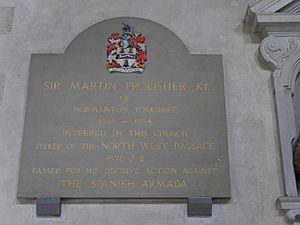
Britain
- A destroyer ship was named HMS Frobisher during its building.
- The Royal Navy cruiser HMS Frobisher was named after him.
- A steam locomotive was named after him.
- Frobisher Crescent, part of the Barbican Estate in London, is named after Frobisher.
- A stained glass window in All Saints' Church, Normanton remembers him.
- Martin Frobisher Infants School in Altofts is named after him.
- One of the four houses at Spratton Hall School is named after him.
- A portrait of him can be found at Normanton railway station.
- Training Ship Frobisher II, a Sea Cadets training place, is named after him.
Canada
- Frobisher Bay in Nunavut is named after him.
- The capital of Nunavut, Iqaluit, was once called Frobisher Bay.
- An early version of Thanksgiving was celebrated after Frobisher's fleet landed safely in Newfoundland.
- A shrub rose is named after Martin Frobisher.
- The small settlement of Frobisher, Saskatchewan, and Frobisher Lake are named after him.
- Several roads are named Frobisher:
- Frobisher Avenue in Toronto, Ontario
- Frobisher Lane in Ottawa, Ontario
- Frobisher Street in Richmond Hill, Ontario
- Frobisher Drive in Waterloo, Ontario
- Frobisher Boulevard in Milton, Ontario
- Frobisher Avenue in Moncton, New Brunswick
- Frobisher Street in Peterborough, Ontario and Sudbury, Ontario
- Frobisher Crescent in Brandon, Manitoba
- Frobisher Crescent in London, Ontario
See also
 In Spanish: Martin Frobisher para niños
In Spanish: Martin Frobisher para niños
- Arctic exploration
- List of Arctic expeditions


